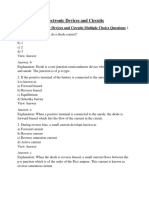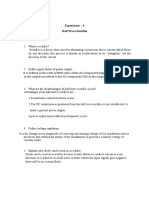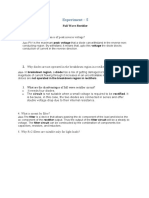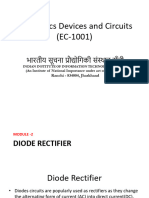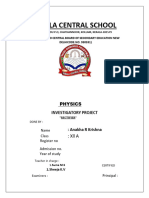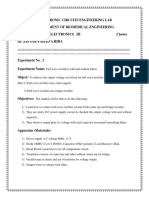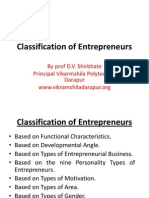0 ratings0% found this document useful (0 votes)
141 viewsFDC Lab Manual
This document describes an experiment to study the V-I characteristics of a diode. The aim, apparatus, theory, circuit diagram, procedure, observation table, graph, results, discussion, precautions and quiz are provided. The key points are:
- The experiment aims to obtain the forward and reverse bias characteristics of a diode by varying the input voltage and recording the current.
- Under forward bias, the diode offers low resistance and conducts current. Under reverse bias, it offers high resistance and does not conduct.
- The I-V characteristics are obtained by plotting a graph of current vs voltage and show the nonlinear behavior of the diode.
- The document also provides a quiz to test the understanding
Uploaded by
tovilasCopyright
© © All Rights Reserved
Available Formats
Download as PDF, TXT or read online on Scribd
0 ratings0% found this document useful (0 votes)
141 viewsFDC Lab Manual
This document describes an experiment to study the V-I characteristics of a diode. The aim, apparatus, theory, circuit diagram, procedure, observation table, graph, results, discussion, precautions and quiz are provided. The key points are:
- The experiment aims to obtain the forward and reverse bias characteristics of a diode by varying the input voltage and recording the current.
- Under forward bias, the diode offers low resistance and conducts current. Under reverse bias, it offers high resistance and does not conduct.
- The I-V characteristics are obtained by plotting a graph of current vs voltage and show the nonlinear behavior of the diode.
- The document also provides a quiz to test the understanding
Uploaded by
tovilasCopyright
© © All Rights Reserved
Available Formats
Download as PDF, TXT or read online on Scribd
You are on page 1/ 25
EXPERIMENT NO: 1
AIM : Study of V-I Characteristics of a Diode.
APPARATUS REQUIRED : Diode Characteristics Kit , Power Supply, Ammeter (0-20mA),
Voltmeter (0-20V), Connecting Leads.
BRIEF THEORY : A P-N junction is known as Semiconductor diode or Crystal diode.
It is the combination of P-type & N-type Semiconductor. Which offers
Nearly zero resistance to current on forward biasing & nearly infinite
Resistance to the flow of current when in reverse biased.
Forward biasing : When P-type semiconductor is connected to the +ve terminal and N-type
to ve terminal of voltage source. Nearly zero resistance is offered to the
flow of current.
Reverse biasing : When P-type semiconductor is connected to the ve terminal and N-type to
+ve
Terminal. Nearly zero current flow in this condition.
CIRCUIT DIGRAM :
(1) When diode is forward biased (2) When diode is reverse biased
DIODE
mA
WHEN A DIODE IS REVERSE BIASED
12V
WHEN A DIODE IS FORWARD BIASED
+
V
-
DIODE
+
-
mA
R
1.5K Ohm
ET
R
15K Ohm
ET
ET
V V
PROCEDURE :
(1) Connect the ckt. as shown in fig.
(2) Switch on the power supply.
(3) Vary the value of input dc supply in steps.
(4) Note down the ammeter & voltmeter readings for each step.
(5) Plot the graph of Voltage Vs Current.
(6) Connect the ckt. as shown in fig.
OBSERVATION TABLE :
When Diode Is Forward
Biased
When Diode Is Reverse
Biased
PROCEDURE
:
Current(mA) Voltage(V) Current
[A)
Voltage(V)
1.
2.
3.
GRAPH :
RESULT : The graph has been ploted between voltage and current.
DISCUSSION: The diode donot conduct in RB state and conduct in FB state.
PRECAUTIONS :
(1)Always connect the voltmeter in parallel & ammeter in series as shown in fig.
(2)Connection should be proper & tight.
(3)Switch ON the supply after completing the ckt.
(4)DC supply should be increased slowly in steps
(5)Reading of voltmeter & Ammeter should be accurate.
QUIZ :
Q.1 Define semiconductor diode ?
A. A PN junction is called semiconductor diode.
Q.2 Define depilation layer ?
A. The region having uncompensated acceptor and donor ions.
Q.3 What do you mean by forward biased ?
A. When +ve terminal of battery is connected to P side & -ve terminal to N side of diode.
Q.4 What do you mean by reverse biased ?
A. When +ve terminal of battery is connected to N side & -ve terminal to P side of diode.
Q.5 Define Knee voltage ?
A. The forward voltage at which current through the junction starts increasing rapidly.
Q.6 Define breakdown voltage ?
A. Reverse voltage at which PN junction breaks down with sudden rise in reverse current.
Q.7 Define threshold voltage ?
A.
Q.8 Write threshold voltage for Ge & Si ?
I (m)A
KNEE VOLTAGE V VK
Q.9 Define max. forward current ?
A. It is highest instantaneous forward current that a PN junction can conduct without damage to
J unction.
Q.10 Define max. power rating ?
A. Max. power that can be dissipated at junction without damage to it.
EXPERIMENT NO : 2
AIM : Study of Half Wave Rectifier .
APPARATUS REQUIRED : Power supply, rectifier kit., CRO, Connecting Leads.
BRIEF THEORY : Rectification is a process of conversion of AC to DC .
In half-wave rectifier, only one diode is used . During +ve half
Cycle the diode is forward biased &, it conducts current through
the load resistor R .During ve half cycle diode is reverse biased
Hence, no current flow through the circuit.
Only +ve half cycle appears across the load, whereas, the ve half
Cycle is suppressed.
CIRCUIT DIGRAM :
DIODE
D1N4448
+
1/P
230V
O/P
-
RL
PROCEDURE :
(a) Connect the ckt. as shown in fig.
(b) Supply the input AC signal to the circuit.
(c) Output signal is obtained on CRO which shows the DC( pulsating output).
(d) Draw the wave form.
WAVE FORM :
Input wave Output wave
Wt 2 3 Wt
0
2 3
Vi
Vm
Vm
Vo
0
RESULT : Input and output waveform of half wave rectifier is as shown.
Discussion: The output obtained is unidirectional, pulsating DC . but ripple factor is large.
PRECAUTIONS :
(a) Connection should be proper & tight.
(b) Switch ON the supply after completing the ckt.
(c) Note down the input & output wave accurately.
QUIZ :
Q.1 Define Rectifier ?
A. A circuit used to convert a.c. voltage into the pulsating d.c. voltage.
Q.2 What is Half-Wave Rectifier ?
A. Rectifier in which diode conduct only for half cycle of waveform.
Q.3 Define PIV ?
A. Max. voltage which a diode can withstand without breakdown in reverse bias conditon.
Q.4 What type of output we get from H-W Rectifier ?
A. In output we get unidirectional pulsating voltage.
Q.5 Write its Disadvantage ?
A. Rectification efficiecy is less & ripple factor is more.
Q.6 Define efficiency .
A. Ratio of d.c. power delivered to the load to the a.c. i/p power from sec. wdg. of transformer.
Q.7 Define Ripple Factor ?
A. It is a measure of purity of output of a rectifier.
Q.8 What is the value of Rf for H-W Rectifier ?
A. 1.21
Q. 9 What is Transformer utilization factor ?
A. Ratio of d.c. power delivered to the load to the a.c. rating of transformer secondary.
Q.10 What is the value of Irms for HW Rectifier ?
A. Im/2.
EXPERIMENT NO : 3
AIM : Study of Full Wave Rectifier .
APPARATUS REQUIRED : Power Supply, Rectifier kit., CRO, Connecting Leads.
BRIEF THEORY : In full-wave rectification, When A.C supplied at the input , both the half
cycles current flows through the load in the same direction. The following
two circuits are commonly employed.
Centre-tap full-wave Rectifier : In this rectifier, two diodes & a center-tap transformer is used .
During +ve half cycle the diode D1 is forward biased & D2 is reverse biased .Output will be
obtained across load resistor R .During ve half cycle diode D1 is reverse biased &D2 is forward
biased. Output will be obtained across load resistor R again & the direction of output is same
i.e, DC output is obtained.
Bridge Rectifier : The ckt. contains four diodes connected to form a bridge. In this an ordinary
Transformer is used. During +ve half cycle of secondary voltage, diodes D1 & D3 are forward
biased & diodes D2& D4 are reverse biased & vice versa.
CIRCUIT DIGRAM :
A
+ 1/P
230V
DIODE
D1 4148
B
D2 4148
-
DIODE
O/P
RL
PROCEDURE :
(d) Connect the ckt. as shown in fig.
(e) Supply the input AC signal to the circuit.
(f) Output signal is obtained on CRO which shows the DC( pulsating output).
(g) Draw the wave form.
WAVE FORM :
Input wave Output wave
RESULT: The input and output waveforms of full wave rectifier has been drawn.
Discussion : The output is unidirectional , pulsating dc . But ripple factor is less than half wave
rectifier.
PRECAUTIONS :
(a)Connection should be proper & tight.
(b)Switch ON the supply after completing the ckt.
(c)Note down the input & output wave accurately.
QUIZ :
Q.1 Define Full wave rectifier ?
A. In which diode conducts for both half cycles of waveform.
Q.2 Different types of FW rectifier ?
A. Center tapped & Bridge Rectifier.
Q.3 Write PIV of Center tapped rectifier.
A. 2Vm.
Q.4 Define Form Factor ?
A. It is ratio of r.m.s. value to average value.
Q.5 Write ripple factor for FW rectifier ?
A. 0.48
Q.6 What is the efficiency of FW rectifier ?
A. 81.2%
Q.7 Write advantages of bridge rectifier ?
A. Diodes PIV rating is Vm & it does not require Centre-tapped secondary winding.
Q.8 Write disadvantage of bridge rectifier ?
A. It requires 4 diodes so it can not be used for low voltage applications.
Q.9 Write output frequency for FW rectifier ?
A. 100 hz .
Q.10 Write value for DC current ?
A. 0.636 Im.
0
2
Vi
2 3
Vo
0
EXPERIMENT NO : 4
AIM: To Study the characteristics of transistor in Common Base configuration .
APPARATUS REQUIRED :
Power supply, Transistor characteristics Kit, Connecting Leads, Voltmeter, Ammeter.
BRIEF THEORY :
Transistor is a semiconductor device consist of two p-n junctions. It has three terminals, to handle I/P
and O/P four terminals are needed . Therefore, one terminal is made common . A transistor can be
connected in three Ways CB, CE, CC.
Common base :
Base is made common. I/P is connected between base & emitter and O/P is taken between base &
collector.
Input charact.
The curve plotted between emitter current I & the emitter-base voltage constant collector-base voltage
V .
Output charact.
The curve plotted between collector current I & collector-base voltage V constant emitter current I.
.
CIRCUIT DIAGRAM :
mA
C
mA
+ -
B
VEB
VEB
12V
+
R1
1k
VCB
R
12V
E
-
PROCEDURE :
Input charact.
(a) Make the connection as per circuit diagram .
(b) Switch ON the supply & set V =0V
(c) Vary V in step & note down the emitter current I at each step .
(d) Set V =1V & again repeat the same procedure .
(e) Draw the graph.
Output charact.
(a) Make the connection as per circuit diagram.
(b) Set the value of I =1mA
(c) Vary V in step & note down the collector current I at each step.
(d) Set I =2mA & repeat the same procedure .
(e) Draw the graph .
OBSERVATION TABLE :
Input charact.(Vcb=Cons.) Output charact. (Ie =Const.)
S.No Ie(mA) Veb(Volts) Ic(mA) Vcb(Volts)
1.
2.
3.
GRAPH : Input charact. Output charact.
RESULT : The input and output charactrtistics of transformer in CB configuration has been ploted.
DISCUSSION:With the help of output characteristics we can calculate ac & dc current gain in CB
configuration.
PRECAUTIONS :
(1) Always connect the voltmeter in parallel & ammeter in series as shown in fig.
(2) Connection should be proper & tight.
(3) Switch ON the supply after completing the ckt.
(4) DC supply should be increased slowly in steps
(5) Reading of voltmeter & Ammeter should be accurate.
QUIZ:
Q1: What do you mean by biasing of transistor?
A. When dc voltages are applied across the different terminals of transistor, it is called biasing.
Q2: What is d.c. current gain in common base configuration?
A. It is ratio of collector current(Ic) to emitter current (Ie).
Q3: What is typical value for d.c. current gain ?
A. 0.99
Q4: What is a.c. current gain in CB confifuration?
A. It is ratio of change in collector current to change in emitter current.
Q5: What are input characteristics?
A. These curves relate i/p current & i/p voltage for a given value of o/p voltage.
Q6: What are output characteristics?
A. Thes curves relate o/p voltage & o/p current for a given value of input current.
Q7: Which configuration has highest voltage gain?
A. Common Emitter.
IE = CONSTANT
VCB
IC
VCB=CONSTANT
IE
VEB
Q8: Which configuration is most widely used?
A. Common Emitter.
Q9: What is operating point?
A. The zero signal values of Ic & Vce.
Q10: Which reigon is heavily doped in Transistot?
A. Emitter.
EXPERIMENT NO :5
AIM : Study of characteristics of J FET in Common Source Configuration .
APPARATUS REQUIRED : Power Supply, FET Characteristics Kit, Connecting Leads,
Voltmeter, Ammeter.
BRIEF THEORY : A FET is a three terminal semiconductor device in which current
Conduction is by one type of carriers & is controlled by the effect of
electric field. There are two types of FET namely J FET & MOSFET.
Again, a J FET can either have N-channel or P-channel. A N-channel
J FET has a N-type semiconductor bar, the two ends of which make the
Drain & source terminal. On the two sides of this bar, P-N junction are
made. These P region makes gate. Usually, these two gates are connected
together to form a single gate .The gate is given a ve bias w.r.t Source.
Drain is given +ve potential w.r.t Source .
CIRCUIT DIGRAM :
D
1
2
1
2
VGS
mA
S
2
3
1
VDS
G
PROCEDURE :
Drain characteristic
(a) Connect the circuit as shown in fig. Keep V & V supplies at minimum.
(b) Switch ON power , Increase V gradually & note the max. current as I while the V =0V
(c) Repeat the step for different values of V , & note corresponding I & V for increment.
(d) Tabulate the results .
Transfer characteristic
(a) Keep V fixed at 4V .
(b) Increase V in small steps & note corresponding I for each step.
(c) Repeat step 2 for different values of V .
(d) Tabulate the results .
OBSERVATION TABLE :
Transfer charact.(Vds=Cons.) Drain charact. (Vgs=Const.)
S.No Id(mA) Vgs(Volts) Id(mA) Vds(Volts)
1.
2.
3.
GRAPH :
RESULT : Transfer & Drain characteristics of J FET in common source configuration has been
plotted.
DISCUSSION: We obseve that characteristics has 4 regions: Ohmic region, curve AB, Pinch off
region& Breakdown region.
PRECAUTIONS :
(6) Always connect the voltmeter in parallel & ammeter in series as shown in fig.
(7) Connection should be proper & tight.
(8) Switch ON the supply after completing the ckt.
(9) DC supply should be increased slowly in steps
(10) Reading of voltmeter & Ammeter should be accurate.
QUIZ :
Q.1 Define FET ?
A It is a 3 terminal device in which current conduction is by only one type of mazority carriers.
Q.2 Define pinch off Voltage ?
A. The value of Vds at which all the free charge carriers are removed from channel.
Q.3 What is unipolar device ?
A. In which conduction is by only one type of mazority carriers.
Q.4 What is bipolar device ?
A. In which conduction is by both types of carriers.
Q.5 Write advantages of FET over conventional Transistor ?
A. It provides extremely high input impedance as compared to BJ T.
Q.6 Define drain Characteristics ?
A. The curve b/w drain current & Vds with Vgs as a parameter.
Q.7 Define transfer Characteristics ?
A. The curve b/w Id & Vgs keeping Vds constt.
Q.8 Write applications of a FET ?
A. FETs are used in ICs, voltage variable resistor in operational amplifier etc.
Q.9 Input impedance of a FET is more than a BJ T , Why ?
A Because it always work in reverse biasing situation.
Q.10 Define amplification factor ?
A. Ratio of change in drain-source voltage to change in gate to source voltage at constt. Id.
EXPERIMENT NO: 6
AIM: To study the operation of clipping and clamping circuit.
APPARATUS REQUIRED CRO, Function Generator, Power supply, connecting leads, clipping and
clamping circuit kit.
THEORY:
Clipping circuit: In this circuit, the shape of the input wave changed, by clipping or removing a
portion of it. The output obtained will be a clipped or limited portion of the input signal.
Positive clipper A circuit that removes positive half cycle of the signal (input voltage) is called a
positive clipper. The out put voltage has the entire positive half cycles clipped off.
During the positive half cycle of input voltage, the diode is forward biased and conducting
heavily. Ideally, it acts as a closed switch and hence the voltage across the diode or the load is zero and
hence the positive half cycle clipped off.
During the negative half cycle the diode is reverse biased and behaves as an open switch. Then
the current flows through the load and the out put (negative half cycle) is available across load. When
the diode polarity is changed in the same circuit, it becomes a negative clipper. The output will have
only positive half cycles.
Clamping circuit A circuit that shifts either positive or negative peak of the signal at a desired DC
level is known as clamper. In fact, the circuit adds DC component (+ve or ve) to the signal in such a
way that it pushes the signal either on the positive side or the negative side. When the circuit pushes
the signal on the +ve side, then negative peak of the signal falls on the zero level. This circuit is called
a positive clamper. On the other hand, when the circuit pushes the signal on the negative side then
positive peak of the signal falls on the zero level. This circuit is called a negative clamper.
The clamper circuit contains a diode and a capacitor. In case of +ve clamper, the diode
conducts during the negative half cycle. The capacitor which is charged to the peak voltage will
behave like a charged battery which adds to the signal voltage during the positive half cycle.
CIRCUIT DIAGRAM:
1
2
1 2
V1
D
I/P VOLTAGE
RL
CLIPPER O/P
D
CLAMPER
C
CLIPPER
PROCEDURE:
1. Connect the circuit according to the diagram and switch on the power supply.
2. Supply the input square wave to the input terminal of the integrator circuit.
3. Set the out put voltage at 1 V peak and frequency at 1 KHz.
4. Observe the out put waveform on the CRO.
GRAPH
CLIPPER CLAMPER
RESULT
The output waveform (triangular shape) is obtained and observed on the CRO.
PRECAUTIONS
1. Connect the circuit properly as shown in fig.
2. Set the input waveform of correct amplitude and frequency.
3. Connect the CRO to the output terminal.
QUIZ
1. What is the voltage gain of an ideal OP-AMP?
2. What is CMRR?
3. What is a voltage follower?
4. What do you understand by slew rate of an OP-AMP?
0
-Vp
0
Vp +Vp
0
-Vp
+Vp<+Vp
OUTPUT WAVE
OUTPUT WAVE
+Vp
+2Vp
0
EXPERIMENT NO: 7
AIM: To study the operation of OP- AMP as an integrator circuit.
APPARATUS REQUIRED CRO, Function Generator, Power supply, connecting leads, Integrator
circuit kit.
THEORY:
In this circuit, the feed back resistor of an OP-AMP is replaced by a capacitor. The output
obtained will be an integral of the input wave.
I (t) =v (t) /R
Out put Voltage=1/C v(t)/R dt =-1/RC V(t) dt
The circuit therefore provides an out put voltage proportional to the integral of the input
voltage. If the input voltage is a constant, v=V, then the output will be a ramp, Out put voltage=-Vt
/RC
CIRCUIT DIAGRAM:
-
+
2
3
6
7
4
O/ P
I / P
10k
INTEGRATOR CIRCUIT
C=0. 1uf
1k
PROCEDURE:
1. Connect the circuit according to the diagram and switch on the power supply.
2. Supply the input square wave to the input terminal of the integrator circuit.
3. Set the out put voltage at 1 V peak and frequency at 1 KHz.
4. Observe the out put waveform on the CRO.
GRAPH
RESULT
The output waveform (triangular shape) is obtained and observed on the CRO.
PRECAUTIONS
1. Connect the circuit properly as shown in fig.
2. Set the input waveform of correct amplitude and frequency.
3. Connect the CRO to the output terminal.
QUIZ
1. What is the voltage gain of an ideal OP-AMP?
2. What is CMRR?
3. What is a voltage follower?
4. What do you understand by slew rate of an OP-AMP?
t
t
I/P
V
O/P
V
OUTPUT WAVE
INPUT WAVE
EXPERIMENT NO: 8
AIM: To study the operation of OP- AMP as a Differentiator circuit.
APPARATUS REQUIRED: CRO, Function Generator, Power supply, connecting leads,
Differentiator circuit kit.
THEORY:
In this circuit, the capacitor is connected in series with the input resistor. It is an electronic
circuit in which the OP-Amp is employed in such a way that the output voltage comes out to be as a
derivative of the input voltage. This type of circuit is called an OP-AMP differentiator. The output is
proportional to the time derivative of the input wave.
Out put Voltage =-R I =-RC d/dt Vin
CIRCUIT DIAGRAM:
-
+
2
3
6
7
4
1K
DIFFERENTIATOR CIRCUIT
0.1uf
I / P
O/ P
PROCEDURE:
1. Connect the circuit according to the diagram and switch on the power supply.
2. Supply the input square wave to the input terminal of the differentiator circuit.
3. Set the out put voltage at 1 V peak and frequency at 1 KHz.
4. Observe the out put waveform on the CRO.
GRAPH
RESULT
The output waveform (Spikes) is obtained and observed on the CRO.
PRECAUTIONS
1. Connect the circuit properly as shown in fig.
2. Set the input waveform of correct amplitude and frequency.
3. Connect the CRO to the output terminal.
QUIZ
1. What is the input impedence of an ideal OP-AMP?
2. What is CMRR?
3. What is meant by virtual ground?
4. What do you understand by input offset voltage of an OP-AMP?
t
I/P
V
t
O/P
V
OUTPUT WAVE
INPUT WAVE
EXPERIMENT NO: 9
AIM: To study the operation of OP- AMP as a Square Wave generator.
APPARATUS REQUIRED CRO, Function Generator, Power supply, connecting leads, Square wave
generator circuit kit.
THEORY:
In this circuit, a square wave out put waveform is generated. It is also known as a free running
multi vibrator or astable multi vibrator.
As soon as the input supply is given to the circuit, both the transistors in the OP-AMP start conducting.
Because of a small difference in their operating characteristics, one of the transistors conducts slightly
more than the other. Therefore conduction of one transistor drives the other transistor in to cut off
state. This means that one transistor is in saturation and the other in cut off state. After some time the
capacitor gets charged to supply voltage Vcc. This changes the conduction of transistors and switching
action takes place.
CIRCUIT DIAGRAM:
R
R
-
+
2
3
6
7
4
10k
R
C
10k 0.05uf
SQUARE WAVE GENERATOR
O/ P
PROCEDURE:
1. Connect the circuit according to the diagram and switch on the power supply.
2. No input signal is required to be fed to the input terminal of the circuit, as it is self
generating.
3. Frequency can be varied by changing the value of RC combination.
4. Observe the out put waveform on the CRO.
GRAPH
RESULT
The output waveform is obtained and observed on the CRO.
PRECAUTIONS
1. Connect the circuit properly as shown in fig.
2. Connect the CRO to the output terminal.
QUIZ
1. What is faithful amplification of a transistor?
2. What is a differential amplifier?
3. What is meant by biasing of transistors?
4. What do you understand by input offset voltage of an OP-AMP?
t
V
EXPERIMENT NO: 10
AIM: To study NAND, NOR, EX-OR Gates
APPARATUS REQUIRED: Power Supply, Digital Trainer Kit, Connecting Leads, ICs
(7400, 7402,7486)
BRIEF THEORY:
NAND GATE: The IC no. for NAND gate is 7400. The NOT-AND operation is known as
NAND
operation. If all inputs are 1 then output produced is 0. NAND gate is inverted
AND gate.
Y =A. B
NOR GATE: The NOR gate has two or more input signals but only one output signal. IC 7402
is
two I/P IC. The NOT- OR operation is known as NOR operation. If all the
inputs are
0 then the O/P is 1. NOR gate is inverted OR gate.
Y =A +B
EX-OR GATE: The EX-OR gate can have two or more inputs but produce one output. 7486 is
two input IC. EX-OR gate is not a basic operation & can be performed using
basic gates.
Y =A+B
PROCEDURE:
(a) Fix the ICs on breadboard & give the input supply.
(b) Connect the +ve terminal of supply to pin 14 & -ve to pin 7.
(c) Give input at pin 1, 2 & take output from pin 3. It is same for all except NOT
& NOR IC.
(d) For NOR, pin 1 is output & pin 2&3 are inputs.
(e) For NOT, pin 1 is input & pin 2 is output.
(f) Note the values of output for different combination of inputs & draw the
TRUTH TABLE.
RESULT: We have learnt all the gates ICs according to the IC pin diagram.
PRECAUTIONS:
1) Make the connections according to the IC pin diagram.
2) The connections should be tight.
3) The Vcc and ground should be applied carefully at the specified pin only.
QUIZ:
.
.
QUESTION ANSWER
Q.1. Define gates ? A1. Gates are the digital circuits, which perform a
specific type of logical operation
Q.2. Define IC ? A2. IC means integrated circuit. It is the integration
of no. of components on a common substrate.
Q.3. Explain Demorgans theorem. A3. (AB)=A+B
(A+B)=A.B
Q.4. (A+A) A =? A4. A
Q5. Define Universal gates. A5. Universal gates are those gates by using which
we can design any type of logical expression.
Q6. When will the output of a NAND Gate be 0 ? A06. When all the inputs are 1.
EXPERIMENT NO: 11
AIM: To study AND, OR, NOT Gates
APPARATUS REQUIRED: Power Supply, Digital Trainer Kit. Connecting Leads, ICs
(7404, 7408, 7432)
BRIEF THEORY:
AND Gate: The AND operation is defined as the output as one if and only if all the
inputs are one. 7408 is the two Input AND gate IC.A&B are the Input
Terminals &Y is the Output terminal.
Y =A.B
OR Gate: The OR operation is defined as the output as one if one or more than one
inputs are one. 7432 is the two Input OR gate IC. A&B are the input terminals
& Y is the Output terminal.
Y =A +B
NOT GATE: The NOT gate is also known as Inverter. It has one input (A) & one
output (Y). IC No. is 7404. Its logical equation is,
Y =NOT A
Y =A
`
PROCEDURE:
(g) Fix the ICs on breadboard & give the input supply.
(h) Connect the +ve terminal of supply to pin 14 & -ve to pin 7.
(i) Give input at pin 1, 2 & take output from pin 3. It is same for all except NOT
& NOR IC.
(j) For NOR, pin 1 is output & pin 2&3 are inputs.
(k) For NOT, pin 1 is input & pin 2 is output.
(l) Note the values of output for different combination of inputs & draw the
TRUTH TABLE.
OBSERVATION TABLE:
SL
NO AND OR NOT
INPUT
OUTPUT INPUT
OUTPUT
INPUT
OUTPUT
RESULT: We have learnt all the gates ICs according to the IC pin diagram.
PRECAUTIONS:
1) Make the connections according to the IC pin diagram.
2) The connections should be tight.
3) The Vcc and ground should be applied carefully at the specified pin only.
QUIZ:
QUESTION ANSWER
Q.1 Define gates ? A1. Gates are the digital circuits, which perform a
specific type of logical operation
Q.2 Define IC? A2. IC means integrated circuit. It is the integration
of no. of components on a common substrate.
Q.3 Explain Demorgans theorem. A3. (AB)=A+B
(A+B)=A.B
Q.4 (A+A) A =? A4. A
Q5 Define Universal gates. A5. Universal gates are those gates by using which
we can design any type of logical expression.
Q6.Write the logical equation for AND gate. A6.Y=A.B
Q7 How many no. of input variables can a NOT Gate
have?
A7. One
Q8.Under what conditions the output of a two input
AND gate is one?
A8. Both the inputs are one
Q9.1+0 =? A9. One
.
.
You might also like
- Inner War and Peace, Insights From The Bhagavad Gita Osho PDF83% (6)Inner War and Peace, Insights From The Bhagavad Gita Osho PDF322 pages
- Vigyan Bhairav Tantra 112 Meditation Techniues100% (1)Vigyan Bhairav Tantra 112 Meditation Techniues3 pages
- Semiconductor Devices and Circuit Lab Manual100% (1)Semiconductor Devices and Circuit Lab Manual46 pages
- NAME - Saurav Gupta Roll No - 19ME3FP14: ApparatusNo ratings yetNAME - Saurav Gupta Roll No - 19ME3FP14: Apparatus26 pages
- ece-i-basic-electronics-10eln-15-solutionNo ratings yetece-i-basic-electronics-10eln-15-solution102 pages
- Experiment - 4 Half Wave Rectifier Pre - Lab QuestionsNo ratings yetExperiment - 4 Half Wave Rectifier Pre - Lab Questions8 pages
- Electronic Devices Lab - Study of Diode Rectifiers - Mid Term - Fall 22-23 - ACSNo ratings yetElectronic Devices Lab - Study of Diode Rectifiers - Mid Term - Fall 22-23 - ACS11 pages
- Experiment - 5: What Is The Importance of Peak Inverse Voltage? AnsNo ratings yetExperiment - 5: What Is The Importance of Peak Inverse Voltage? Ans5 pages
- Al-Balqa' Applied University: Electronics LabNo ratings yetAl-Balqa' Applied University: Electronics Lab54 pages
- Exp 2 Study of Half Wave and Full Wave Diode RectifiersNo ratings yetExp 2 Study of Half Wave and Full Wave Diode Rectifiers9 pages
- Scan Sep 14, 2024 12 - 22 - 31 PM - Print (3) AnakahaNo ratings yetScan Sep 14, 2024 12 - 22 - 31 PM - Print (3) Anakaha14 pages
- 1.15.crystal Diode As A Rectifier:: Is Zero. Both The Load Voltage and Current Are of Are Shown in Figure 1.29No ratings yet1.15.crystal Diode As A Rectifier:: Is Zero. Both The Load Voltage and Current Are of Are Shown in Figure 1.2910 pages
- Basic Electronics Lab: Laboratory ManualNo ratings yetBasic Electronics Lab: Laboratory Manual10 pages
- Design of Electrical Circuits using Engineering Software ToolsFrom EverandDesign of Electrical Circuits using Engineering Software ToolsNo ratings yet
- Semester-I/II/III/IV/V/VI A.T.K.T Examination Form Semester B.C.F.M./B.SC (CS) / B.Sc. (IT) / M.Sc. (IT)No ratings yetSemester-I/II/III/IV/V/VI A.T.K.T Examination Form Semester B.C.F.M./B.SC (CS) / B.Sc. (IT) / M.Sc. (IT)1 page
- M.C.a (Sem - III) Paper - I - Object Oriented ProgrammingNo ratings yetM.C.a (Sem - III) Paper - I - Object Oriented Programming179 pages
- (TRI01344) JW Menu For Vandaag (Taj Gate Way) - A4 - PG 01&02No ratings yet(TRI01344) JW Menu For Vandaag (Taj Gate Way) - A4 - PG 01&022 pages
- Financial Reports and Notes To The Financial Statements: UnderstandingNo ratings yetFinancial Reports and Notes To The Financial Statements: Understanding7 pages
- Cuestionario Proveedores Agrocommerce V Final RNo ratings yetCuestionario Proveedores Agrocommerce V Final R6 pages
- Lecture 5 and 6 - Marginal Absorption CostingNo ratings yetLecture 5 and 6 - Marginal Absorption Costing23 pages
- TECH II SP06 Lyon Airport Station Case Study100% (1)TECH II SP06 Lyon Airport Station Case Study2 pages
- 07 - Petty Cash Fund and Bank Reconciliation100% (2)07 - Petty Cash Fund and Bank Reconciliation2 pages
- Example Financial Statements Risk AnalysisNo ratings yetExample Financial Statements Risk Analysis7 pages
- Calculating The Cost of Capital: Team Eddie'sNo ratings yetCalculating The Cost of Capital: Team Eddie's37 pages
- Is Britain Ready To Be Honest About Its Decline - BloombergNo ratings yetIs Britain Ready To Be Honest About Its Decline - Bloomberg5 pages
- ST 2N2222 / 2N2222A: Semtech Electronics LTDNo ratings yetST 2N2222 / 2N2222A: Semtech Electronics LTD4 pages
- The East Pacific Merchandising Corporation vs. The Director of Patents and Luis P. PellicerNo ratings yetThe East Pacific Merchandising Corporation vs. The Director of Patents and Luis P. Pellicer1 page
- Jahangirnagar University: Institute of Business Administration (IBA-JU)No ratings yetJahangirnagar University: Institute of Business Administration (IBA-JU)5 pages
- Digital Asset Human Capital Trends BriefNo ratings yetDigital Asset Human Capital Trends Brief2 pages
- Inner War and Peace, Insights From The Bhagavad Gita Osho PDFInner War and Peace, Insights From The Bhagavad Gita Osho PDF
- NAME - Saurav Gupta Roll No - 19ME3FP14: ApparatusNAME - Saurav Gupta Roll No - 19ME3FP14: Apparatus
- Experiment - 4 Half Wave Rectifier Pre - Lab QuestionsExperiment - 4 Half Wave Rectifier Pre - Lab Questions
- Electronic Devices Lab - Study of Diode Rectifiers - Mid Term - Fall 22-23 - ACSElectronic Devices Lab - Study of Diode Rectifiers - Mid Term - Fall 22-23 - ACS
- Experiment - 5: What Is The Importance of Peak Inverse Voltage? AnsExperiment - 5: What Is The Importance of Peak Inverse Voltage? Ans
- Exp 2 Study of Half Wave and Full Wave Diode RectifiersExp 2 Study of Half Wave and Full Wave Diode Rectifiers
- Scan Sep 14, 2024 12 - 22 - 31 PM - Print (3) AnakahaScan Sep 14, 2024 12 - 22 - 31 PM - Print (3) Anakaha
- 1.15.crystal Diode As A Rectifier:: Is Zero. Both The Load Voltage and Current Are of Are Shown in Figure 1.291.15.crystal Diode As A Rectifier:: Is Zero. Both The Load Voltage and Current Are of Are Shown in Figure 1.29
- Design of Electrical Circuits using Engineering Software ToolsFrom EverandDesign of Electrical Circuits using Engineering Software Tools
- Semester-I/II/III/IV/V/VI A.T.K.T Examination Form Semester B.C.F.M./B.SC (CS) / B.Sc. (IT) / M.Sc. (IT)Semester-I/II/III/IV/V/VI A.T.K.T Examination Form Semester B.C.F.M./B.SC (CS) / B.Sc. (IT) / M.Sc. (IT)
- M.C.a (Sem - III) Paper - I - Object Oriented ProgrammingM.C.a (Sem - III) Paper - I - Object Oriented Programming
- (TRI01344) JW Menu For Vandaag (Taj Gate Way) - A4 - PG 01&02(TRI01344) JW Menu For Vandaag (Taj Gate Way) - A4 - PG 01&02
- Financial Reports and Notes To The Financial Statements: UnderstandingFinancial Reports and Notes To The Financial Statements: Understanding
- Is Britain Ready To Be Honest About Its Decline - BloombergIs Britain Ready To Be Honest About Its Decline - Bloomberg
- The East Pacific Merchandising Corporation vs. The Director of Patents and Luis P. PellicerThe East Pacific Merchandising Corporation vs. The Director of Patents and Luis P. Pellicer
- Jahangirnagar University: Institute of Business Administration (IBA-JU)Jahangirnagar University: Institute of Business Administration (IBA-JU)














